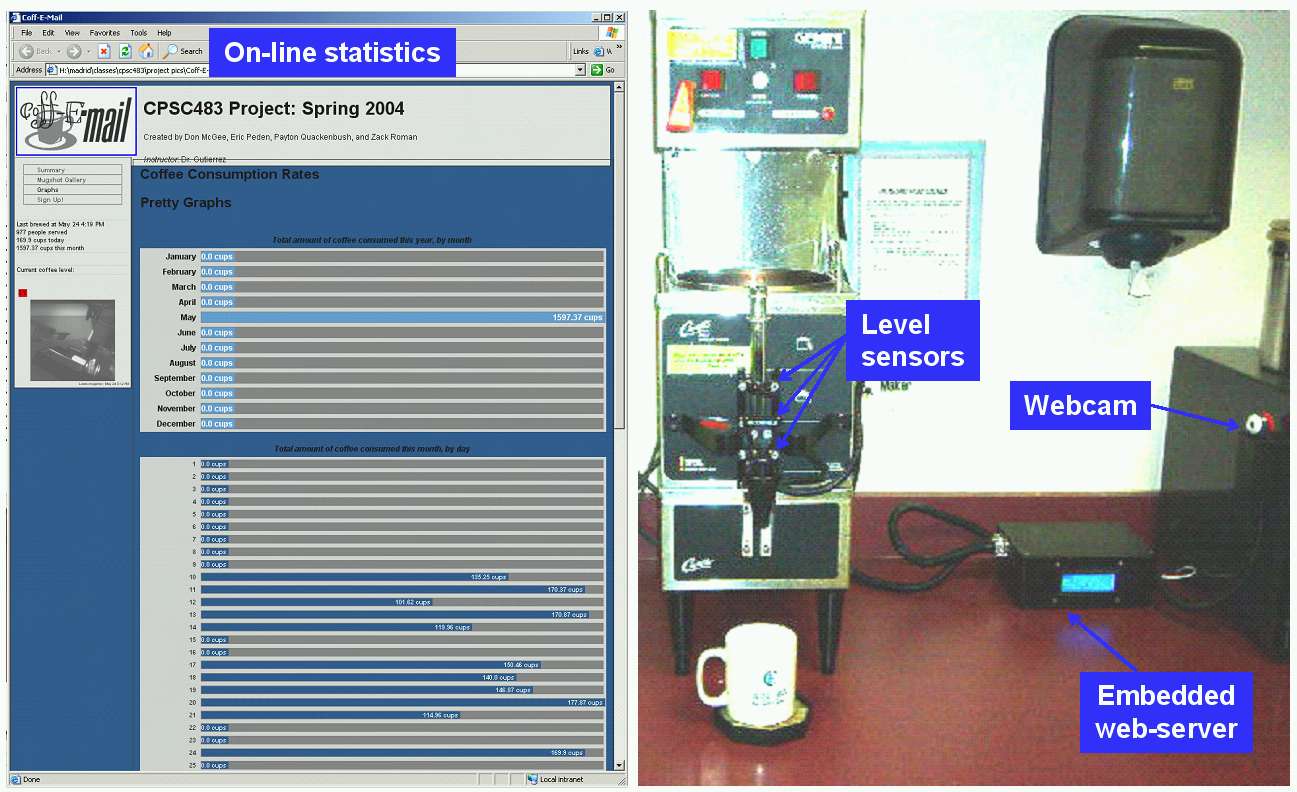Home
Documents
Projects
Links
Gallery
Contact
|
|
Gallery of movie demos
from (some) previous projects
Gallery of pictures
from (some) previous projects

|
Air quality monitoring
with a network of chemical sensors. The goal of this project was
to develop a sensor network for monitoring carbon-monoxide (CO)
emissions inside campus buildings. The system consisted of an array
of Crossbow® motes, each mote housing an electrolytic CO sensor.
The network was able to detect CO concentrations in the low parts-per-million
range, and provide 24/7 on-line data visualization through the
campus network.. |
|
|
|
Fly-by-wire control for a robotic helicopter.
The objective of this project was to develop an autonomous controller
for a small helicopter vehicle, along with a fast switch to allow
the user to regain manual control when needed. The students designed
a microcontroller system, also based on the Gumstix/Robostix platform,
which included pulse-width-modulated controls for five servo motors,
and inputs from an Inertial Measurement Unit (IMU), a Global Positioning
System (GPS), an ultrasonic rangefinder, and a digital compass.
The final product was turned over to Professor Dez Song in our
department, who will use it on his robotic helicopter..
|
 |
|
|
|

|
Visual servoing.
The goal of this project was to develop a human-robot interface
that would allow a user to explore a remote environment with a
mobile robot. The system consisted of a small wheeled robot with
a wireles camera and a wireless PDA, and a workstation with a webcam.
The user would receive live feed from the robot camera, and would
control the robot movements by making prespecified head movements
(see figure) in front of the webcam. Right/left head
shakes would command the robot to make right/left turns, up/down
head nods would command the robot to move forward or stop. A watchdog
safety thread ran on the robot's PDA to stop the robot if communications
with the user were disrupted. |
|
|
|
Robot
control with EMG signals.
The goal of this project was to develop a human-robot interface
based on physiological signals. The system consisted of an
array of electromyogram (EMG) sensors, which detected electrical
activity in different muscles of the user, a DSP board that
performed pattern recognition on the EMG signals, and a small
mobile robot controlled via RF. The user would train the pattern
classifier on a subset of hand gestures which, when expressed
at a later time, would serve as individual commands for the
robot.
|
 |
|
|
|

|
Coff-e-mail.
The goal of this project was to develop a low-cost embedded web-server
that would keep logs of coffee consumption in the department’s
student lounge. The system contained photocells for measuring current
levels of coffee, motion sensors for detecting when coffee was
being poured, and a low-cost camera to capture an image of the
coffee mug. The system kept statistics on-line and also informed
registered users when a fresh coffee pot was being brewed. |
|
|
|
Motion tracking
with infra-red imaging. The goal of this
project was to develop a motion capture system based on IR imaging.
The students designed a head-mounted frame to allow recovery of 3D
head rotations (roll,
pitch and yaw), developed a graphical user interface, automated
a number of otherwise time-consuming tasks (e.g., initial detection
of markers in the face), and integrated the audio-visual capture
system with an MPEG-4 compliant facial animation engine. |
|
|
|
|
|
Omni-Directional
Vision System for Mobile Robots.
The objective of this project was to design and integrate an omni-directional
vision system (ODVS) for a mobile robot. The ODVS consisted of a
CCD array (based on the CMUCam) coupled with a spherical mirror (a
chromed light bulb), that generated a 360-degree view of the surroundings
of the robot. The students were able to integrate the ODVS with a
miniature mobile robot, and track a color moving target in real-time. |
|
|
|
Acoustic
Navigation for Mobile Robots. The goal of this project
was to develop a microphone array to allow a miniature mobile
robot to detect acoustic beacons. The array consisted of eight
miniature microphones in a ring configuration to provide 360
degree sound localization. The students designed a custom printed
circuit interface board for the microphones, which also contained
a programmable filter bank that allowed the robot to “listen” to
eight different center frequencies. |
 |
|
|
|
|
Dead-Reckoning
System for Mobile Robots. The objective
of this project was to design a dead-reckoning system for mobile
robots based on odometry, inertial navigation and a digital compass.
Odometry was achieved with optical encoders attached to the wheel
axles of a miniature robot. The inertial navigation consisted of
a 2-axis MEMS accelerometer and a MEMS gyroscope, which allowed the
robot to measure linear and angular accelerations. These two dead-reckoning
modalities were complemented with information from a digital compass.
The students also investigated sensor fusion strategies to combine
information from all these sensors. |
|
|








